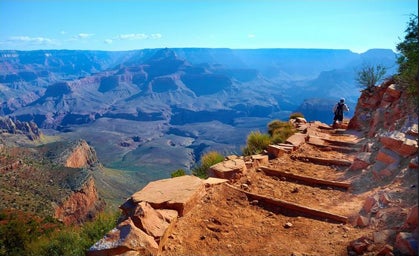Grand Canyon National Park to Institute Interim Permit System

Organized, non-commercial activities in the inner canyon, including rim-to-rim runs, will require permits beginning September 15
Photo by Moyan Brenn, Creative Commons
Grand Canyon National Park announced Wednesday that it will soon begin requiring and issuing Special Use Permits for organized non-commercial rim-to-rim and extended day use activities, including hiking and running, in the section of the park known as the inner canyon.
The permit program, which is an interim measure pending updates to the park’s Backcountry Management Plan, will take effect beginning September 15. The “inner canyon” includes the area from below Tonto Platform from the south rim to the area below Manzanita Resthouse from the north rim. This encompasses the Bright Angel and North and South Kaibab Trails in the corridor, which rim-to-rim efforts follow.
The number of permits will not be limited by the National Park Service (NPS), but groups will be limited to 30 individuals.
Park Public Affairs Officer Maureen Oltrogge says the policy is a response to the increased strain on park resources as rim-to-rim efforts have gained popularity in recent years.
“Last May, for example, when the north rim opened, we were seeing significant increases in use,” she says. “As an example, our waste water treatment plant at Phantom Ranch was operating at 110 percent. We saw increases in litter and gear left on the trail, in human waste on the trail, and in overcrowding at the trailheads.”
The NPS estimates that up to 800 people are traveling the corridor trails during peak weekends in the spring and fall.
“How do we manage that activity in a way that people can enjoy rim-to-rim events without affecting those resources?” says Oltrogge, who notes that the permits will include educational resources on Leave No Trace principles and trail etiquette, including right-of-way rules. “We’re looking at this as an opportunity to educate people on the canyon.”
She also says rim-to-rim runs fall under the auspices of organized, non-commercial backcountry activities, for which the park already requires permits.
It was previously reported that the NPS might be addressing resource management related to increased inner canyon use – possibly regulating rim-to-rim activity – in a draft of an environmental impact statement that would be open to public comment before being finalized and revising the park’s 1988 Backcountry Management Plan; an interim regulatory plan was not discussed in our previous interview with park officials. The draft is expected this fall.
Oltrogge stresses that the permit system is an interim measure and will serve to help the NPS collect data on its effect prior to the release of its draft environmental impact statement, and that the draft will still be open for public comment for 60-90 days before it is finalized.
“We’re encouraging people to follow that process and be engaged in that process because we want feedback,” she says. “How the canyon’s use will be managed will be in that plan. We will continue to collect data during the permit process to better understand its impact.”
The draft environmental impact statement as well as a link to the National Park Service’s Planning, Environment and Public Comment website will be posted on Grand Canyon National Park’s website. Runners can also visit the Backcountry Management Plan website. for more information or to contact park officials with questions or concerns. There will also be public meetings held to address questions and comments during the open comment period.